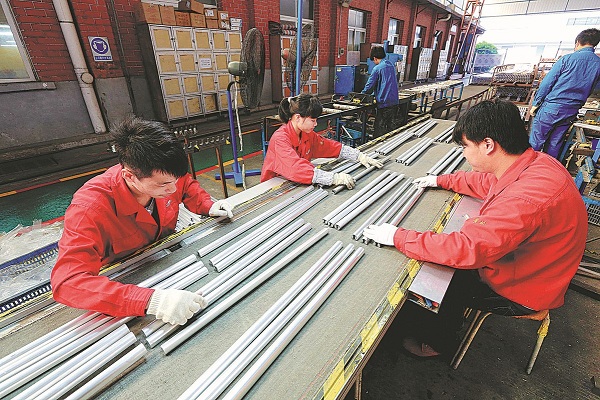Aluminum market battles price rise

Employees check aluminum products at a plant in the Guangxi Zhuang autonomous region. [Photo/CHINA DAILY]
Market concerns about a COVID-19 outbreak in Baise in South China's Guangxi Zhuang autonomous region, a major domestic aluminum production hub, coupled with low levels of global inventory, are expected to further inflate aluminum prices, analysts said on Friday.
Baise, which accounts for 5.6 percent of China's total production of electrolytic aluminum, saw its production suspended amid a citywide lockdown since Feb 7 for epidemic prevention, which sparked fears about supply tightening in both domestic and overseas markets.
China's aluminum supply was seriously affected due to the lockdown, which has sent global prices of aluminum to a 14-year high, reaching 22,920 yuan ($3,605) per ton on Feb 9.
Zhu Yi, a senior analyst for metals and mining at Bloomberg Intelligence, said she believes the production halt in Baise will fuel further price rises as output at factories in North China has been suspended during the recent seven-day Spring Festival holiday, during which most factories nationwide ground to a halt in production or reduced output.
"Home to around 3.5 million people, Baise, with an annual alumina capacity of 9.5 million tons, is a hub of aluminum mining and production in China and accounts for more than 80 percent of the output in Guangxi, China's main alumina-exporting region with around 500,000 tons of shipment of alumina per month," said Zhu.
"Aluminum supply in China, the world's biggest producer of aluminum, is a crucial component in major industries, including automobiles, construction and consumer goods. It will substantially affect global aluminum pricing as China is the world's largest producer and consumer of aluminum."
"Higher raw material costs, low aluminum inventory, and the market concerns about the supply disruptions are likely to further drive up prices of aluminum."
Baise's local industry association said on Tuesday that while aluminum production was largely at normal levels, the transportation of ingots and raw materials was seriously affected by travel restrictions during the lockdown.
This, in turn, has exacerbated market expectations of hindered logistics flows, as well as expectations of phased supply tightening caused by an output drop.
Prices of aluminum were already expected to rise after the holiday ended on Feb 6, due to low domestic inventories and solid demand from manufacturers, according to Shanghai Metals Market, an industry monitor.
Li Jiahui, an analyst with SMM, was quoted by Global Times as saying the lockdown merely aggravated an already fraught price situation as supplies in both domestic and overseas markets have been tightening consistently for a while now.
Li said he believes the lockdown in Baise will impact the aluminum market only in China's southern parts as provinces like Shandong, Yunnan, Xinjiang Uygur autonomous region and North China's Inner Mongolia autonomous region are also major aluminum producers.
Aluminum and related companies in Guangxi are also making efforts to ease the impact of transport restrictions in Baise.
For instance, Huayin Aluminium, a major smelter in Baise, has suspended three production lines to ensure sufficient raw materials for consistent production procedures.
Wei Huying, head of the publicity department of Guangxi GIG Yinhai Aluminum Group Co Ltd, said the company has been stepping up efforts to ease the impact of the transport restrictions, in order to ensure production goods remain sufficient and to avoid possible output suspension due to blocked delivery of raw materials.
While existing inventory could last several days more, the company is trying to ensure supply of necessary raw materials resumes as soon as virus-related restrictions end, she said.
